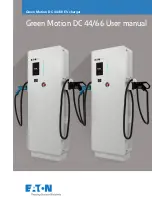
I01�High-voltage�Components
10.�REME
159
If�a�convenience�charging�electronics�is�installed�in�the�vehicle,�the�REME�is�connected�via�a�two-pin
HV�cable�and�a�flat�HV�connector�to�the�KLE.�The�KLE�is�also�connected�to�the�EME�via�a�two-pin
high-voltage�cable�and�a�flat�high-voltage�connector.�The�3-phase�AC�voltage�generated�by�the�range
extender�electrical�machine�is�converted�by�the�REME�to�direct�current�voltage�and�fed�from�the�REME
via�the�KLE�to�the�EME�via�the�high-voltage�cables.�The�energy�required�to�start�the�range�extender
combustion�engine�is�provided�by�the�high-voltage�battery.�The�direct�current�voltage�is�directed�via
the�EME�and�KLE�to�the�REME�by�two-pin�high-voltage�cables.�The�EME�and�the�KLE�do�not�convert
this�direct�current�voltage,�it�is�used�solely�for�the�contact.�With�this�type�of�contact�(via�KLE)�only�one
version�of�the�EME�(irrespective�of�the�equipment)�has�to�be�installed�in�the�I01.
10.3.3.�Connections�for�coolant�lines
The�range�extender�electrical�machine�electronics�is�integrated�in�the�cooling�circuit�of�the
electric�motor.�This�cooling�circuit�is�described�in�detail�in�chapter�11�"Cooling�the�electric�motor
components".
10.3.4.�Connection�for�potential�compensation�line
The�housing�of�the�REME�is�connected�to�the�rear�axle�module�and�thus�ground�via�a�potential
compensation�line.�The�potential�compensation�line�is�secured�using�a�screw�connection.
10.4.�Structure�and�functions
The�range�extender�electrical�machine�electronics�is�made�up�internally�of�two�subcomponents:
the�bidirectional�DC/AC�converter�and�the�REME�control�unit.�The�link�capacitors�for�smoothing�the
voltage�and�filtering�high-frequency�parts�are�also�an�element�of�the�power�electronics�switching.�It
performs�the�following�functions�with�help�of�the�subcomponents�mentioned:
•
Control�of�the�electrical�machine�(engine�speed,�torque)�using�DC/AC�converter
•
Reading�and�evaluation�of�the�temperature�sensor�of�the�range�extender�electrical�machine
•
Reading�and�evaluation�of�the�rotor�position�sensor
•
Contact�of�the�range�extender�electrical�machine
•
Contact�of�the�electrical�machine�electronics�or�the�convenience�charging�electronics
•
Communication�with�other�control�units
•
Active�and�passive�discharging�of�the�link�capacitors�to�voltages�less�then�60 V
•
Self-test�and�diagnostic�function
The�power�electronics�for�the�activation�of�the�electrical�machine�are�mainly�made�up�of�the
bidirectional�DC/AC�converter.�It�is�a�pulse�converter�(also�called�"inverter")�with�a�two-pin�DC�voltage
connection�and�a�3-phase�AC�voltage�connection.�This�DC/AC�converter�can�work�as�an�inverter�and
conduct�electrical�energy�from�the�high-voltage�battery�to�the�range�extender�electrical�machine�when
it�should�work�as�an�engine.�However,�it�can�also�work�as�a�rectifier�and�transfers�electrical�energy
from�the�range�extender�electrical�machine�(via�EME�or�KLE)�to�the�electrical�machine�or�high-voltage
battery.















































